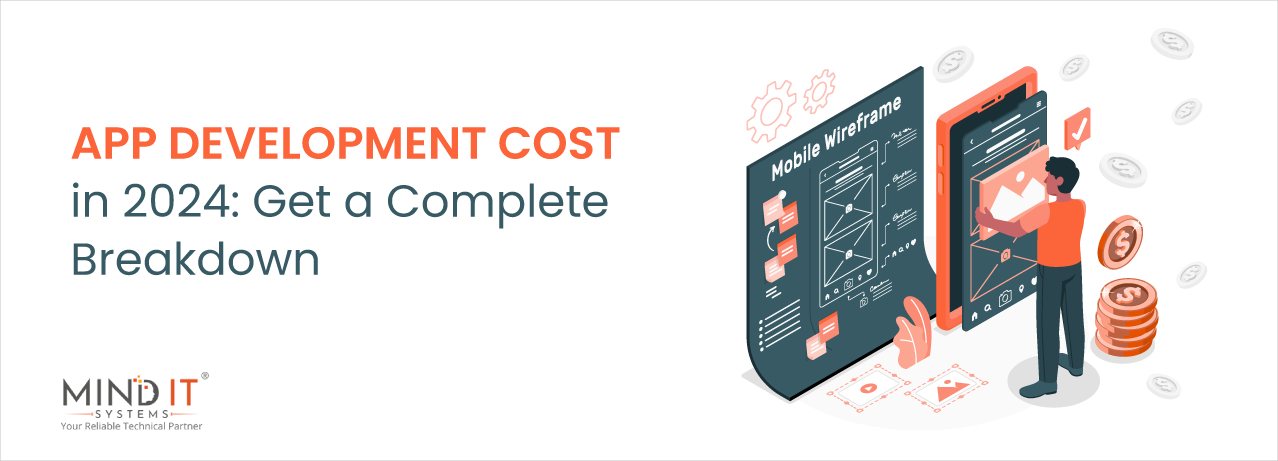
App Development Cost in 2024: Get a Complete Breakdown [Part-1]
Apps are indeed the lifeline of today’s modern world!
In this digital era, where apps are everywhere, business owners are on the quest to bring their business to their mobile devices. Often, they wonder about the app development cost when they stand in the app market. Wondering how much it costs to develop an app. What things affect the costs, and is it too little or too much?
The truth is – the tagline for price depends on things such as the number and complexities (in both design and function), platform choice, online maintenance, and QA requirements.
If you’re planning an app development project in 2024, our blog has got you covered. We’ve created a four-part series to help you understand the costs involved.
Continue reading to explore the different components that can affect app development costs and the areas that can touch the app estimate, ultimately revealing the process of budgeting your app.
This Blog Series Covers
Aspects that Affect the App Development Cost
First and foremost, your app development cost can be influenced by various factors, such as the development approach, the expertise of the developer, the complexity of the app’s features, the availability of reusable off-the-shelf components, and more.
In today’s blog series, we have discussed about the various “App Development Stages.” – one of the most elementary factors that can impact your app development costs in 2024.
So, let’s begin our journey!
Cost Breakdown Based on Various App Development Stages
Following the solid pillars of app development stages is essential if you want your app development project to run smoothly. Here’s a comprehensive breakdown of the app development stages. Understanding how each stage impacts the overall app development cost will enable you to determine how to budget in 2024.
Discovery Phase
The discovery phase is crucial since it uncovers the true potential of your product. So far as app development cost is concerned, the discovery stage is comparatively lower on the budget. Based on the project possibility, the business analysis is done. Here, you need to keep in mind that the development method you adopt can significantly impact your development timeline.
For instance, if you choose agile development, drawing the plan for the next few sprints takes only a couple of days. On the other hand, if you’re thinking of a waterfall approach, it might count on somewhere 10% more on your app’s costs.
Prototyping and Design
It’s more than just the use of colors…
Proceeding to the next step – creating the solution’s user experience and designing its graphical assets.
It can help to determine the cost of designing the app, and the correct way to do it is by developing a clickable prototype. Your prototype consists of wireframes – a rough representation of the screens with clickable elements.
When it’s all about the design of an app, it does not just mean the color schemes or icons. But it refers to the overall design of the app – aesthetics of a finished product, user interface, and user experience. For a customer, it means more than any animation and nice-looking logos; they solve the customer’s difficulties. In the actual world, it’s the task of both the design and development teams to ensure no users are left amazed to understand the app’s design and how it functions.
The app development cost may be higher for complex cases like custom ones built from scratch. For example, a user-rich app like Uber has a few sections with a high level of customization for every screen and platform-specific UX behavior. It might cost more than an enterprise app with minimum application development needs.
Wireframes, Interfaces, and Testing…
This phase of the design process starts with an illustrative flow on how a user uses the software – it refers to the user’s journey. This helps to understand how many screens are required to design the app. And depending upon that, how much overall work needs to be put into the design. The wireframes for the app are created based on the user journey. These are basic and promptly elaborated with client input.
After creating the wireframe, the app’s actual elements are designed, which includes selecting colors, fonts, animations, and the overall style of the application. The app’s design always takes your brand image into account.
When developing an application, designing and prototyping typically takes some time, while front-end work may require additional effort to complete. However, it’s important to keep in mind that the initial cost estimate only covers the first attempt and may be subject to change based on the specific requirements and feedback for the application.
User Testing…
You should allocate a budget for evaluating prototypes with real users to determine the app development cost. Remember to go for user testing after prototyping. It can help you to get an idea of cost estimation for application development. User testing helps to determine whether users are moving through the user journey that is thought of or failing to move past a particular phase.
Often, user testing leads to some design revisions, which results in further testing. Hence, this part of the process is ideally open-ended regarding time commitment since it involves rinsing and repeating the design process until it becomes entirely right.
Development
App development costs are mainly determined by the coding process, which usually accounts for 50-70% of the total cost. The coding time varies depending on the type of app. Whether an app is built from scratch or uses an existing codebase, in both cases it affects the app development cost.
Conducting a thorough discovery phase before starting the development work on any existing project is paramount. To ensure a smooth discovery phase, effective communication with the developers and proper documentation of any existing bugs or issues are crucial. A lack of documentation or knowledge can increase the app development cost and billable hours.
Backend Code
Most applications, whether they are designed for scheduling patient appointments, babysitting hours, finding specialized recipes, tracking disease symptoms, or displaying a personal blog, will require a backend system. It means your app will need a database for storing product information, a payment processor for handling payments, or a CMS for managing content. Unless your app is a simple calculator or an essential to-do list, it will likely need a backend system to function correctly.
Many popular SaaS backends offer pre-made solutions to simplify writing certain parts of an application. For example, Shopify’s SDK enables store owners to create iOS and Android apps that integrate with Shopify’s e-commerce functionality, such as carts, products, discount codes, payment, and more.
These readily available tools can significantly reduce the development cost of Android and iPhone applications.
However, while these packaged components can dramatically reduce the development time for the core features of a mobile or web solution, there may be potential downsides to their simplicity.
What are the potential downsides of Packaged (off-the-shelf) Components? Get to know.
- It is important to note that while packaged components render simplicity that can be helpful, but they may also limit the expandability of an app. For instance, WordPress is an excellent option for websites with static content, such as blogs, that do not change frequently. However, there may be better choices for sites with dynamic content, like large product catalogs that require numerous searches and filters to cater to a vast customer base.
- Apart from the expandability problem, customizing off-the-shelf components can be more time-consuming than building from scratch.
Overall, the app development cost and time depend basically on the features the solution offers, their complexities, accessibility, and feasibility of the pre-existing open-source software and SaaS platforms.
QA Testing
Bugs and outdated features are among the most common reasons why apps fail. So, before your app is released onto the market, it must undergo testing to ensure its quality.
App developers must perform unit and system testing during app development. Unit testing ensures that newly added features are evaluated individually, while system testing examines the app’s usability and performance. Overall, Quality assurance (QA) is crucial, ensuring that the app performs well and satisfies the clients’ and developers’ expectations.
Your app development cost for Android or iPhone depends on the required tests, including regression tests, which check for previously fixed issues to ensure they remain resolved.
Deployment
Once your software is developed, it’s time to get deployed. This stage takes very little time in contrast to other stages. Hence, it is often overlooked by entrepreneurs and some app development teams. Ensure your app developers include this crucial phase in the roadmap.
Maintenance and Support
Just as machines require maintenance, so does a well-functioning application.
Nowadays, most applications rely on cloud service providers such as AWS, Google Cloud, or Azure, which can cost anything from a few pennies to thousands of dollars per month, depending on the usage scale.
Additionally, many third-party services like payment systems operate under a SaaS model, which means the product must pay subscription costs. With the increasing popularity of the app, its throughput requirements increase in both areas, thus enhancing the app development cost associated with it.
With this, we’re concluding our first series. Keep an eye on our blog posts section for the next series.
In our next blog series, we will be discussing the second critical element that can affect your app development cost in 2024, i.e. the “Type of App You’re Developing.”
Don’t miss it out!
Share this post
About the Author

Sujoy Roy
(Head – Digital Marketing)
From my teenage time, I had a quench to solve problems and loved leadership. Starting my career in relation management, ignited my passion for managing people. While managing I realized technology needs to be incorporated to keep pace with the changing world & do my work efficiently.

